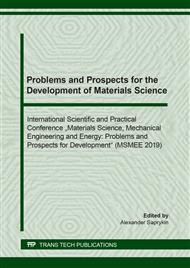[1]
L. Boinovich, A.M. Emelyanenko, V.V. Korolev, A.S. Pashinin, Effect of wettability on sessile drop freezing: when superhydrophobicity stimulates an extreme freezing delay, Langmuir. 30(6) (2014) 1659–1668.
DOI: 10.1021/la403796g
Google Scholar
[2]
L.B. Boyunovich, Superhydrophobic coatings - a new class of polyfunctional materials, Bulletin of the Russian Academy of Sciences. 8(1) (2013)10-22.
Google Scholar
[3]
S.A. Kulinich, M. Farzaneh, How wetting hysteresis influences ice adhesion strength on superhydrophobic surfaces, Langmuir. 25(16) (2009) 8854–8856.
DOI: 10.1021/la901439c
Google Scholar
[4]
G. Momen, R. Jafari, M. Farzaneh, Ice repellency behaviour of superhydrophobic surfaces: Effects of atmospheric icing conditions and surface roughness, Applied Surface Science. 349 (2015) 211–218.
DOI: 10.1016/j.apsusc.2015.04.180
Google Scholar
[5]
S. Zheng, Q. Hu.Fu, et al, Development of stable superhydrophobic coatings on aluminum surface for corrosion-resistant, self-cleaning, and anti-icing applications, Materials & Design. 93 (2016) 261–270.
DOI: 10.1016/j.matdes.2015.12.155
Google Scholar
[6]
L.B. Boinovich, A.M. Emelyanenko, V.K. Ivanov, A.S. Pashinin, Durable icephobic coating for stainless steel, ACS Applied Materials & Interfaces. 5(7) (2013) 2549–2554.
DOI: 10.1021/am3031272
Google Scholar
[7]
T.M. Schutzius, S. Jung, T. Maitra, et al., Physics of icing and rational design of surfaces with extraordinary icephobicity, Langmuir, 31(17) (2014) 4807–4821.
DOI: 10.1021/la502586a
Google Scholar
[8]
V.I. Loganina, S.N. Kislitsyna, K.A. Sergeeva, The choice of polymer concentration in the development of a formulation for anti-icing coating, Bulletin PGUAS: construction, science and education. 1(8) (2019) 19-22.
Google Scholar
[9]
R. V. Goldstein, V.P. Epifanov, To measure the adhesion of ice to other materials, Bulletin of Perm State Technical University, Mechanics.2 (2011) 28-41.
Google Scholar


